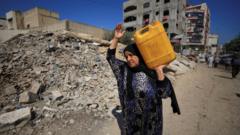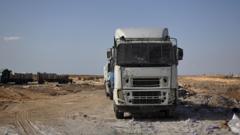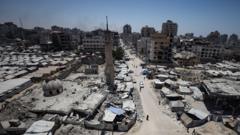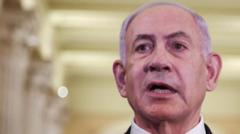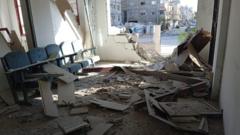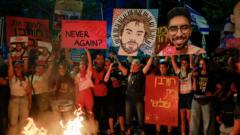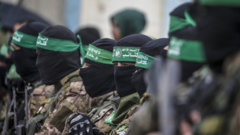**Despite the ongoing conflict and financial pressures, Hamas manages to pay its civil servants through a covert cash transaction method, highlighting the dire humanitarian situation in the region.**
**Hamas's Secret Cash Distribution Amid Crisis**
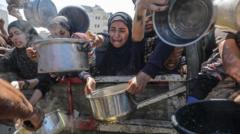
**Hamas's Secret Cash Distribution Amid Crisis**
**A clandestine payment system maintains salaries amid severe hardships in Gaza.**
In the midst of a prolonged and devastating conflict, Hamas continues to operate a covert payment system to distribute salaries to approximately 30,000 civil servants, despite facing substantial military and political challenges. Reports reveal that a cash-based payment method allows the organization to channel around $7 million (£5.3 million) every ten weeks to its employees, with many receiving only a fraction of their normal salaries due to the prevailing economic turmoil.
The reality for many civil servants is grim. Numerous employees, including teachers and police officers, have reported receiving only about 20% of their salaries as soaring inflation exacerbates their struggles. The conditions are so dire that critical supplies, such as flour, have soared to unprecedented prices, deepening food scarcity.
With the banking infrastructure in Gaza rendered nonfunctional, receiving salaries poses tangible risks. Employees receive encrypted messages on their personal devices, directing them to discreet locations to collect their payments. At these rendezvous points, officials are met by individuals who deliver sealed envelopes of cash before disappearing, perpetuating a climate of fear and uncertainty.
A school teacher, whose identity has been concealed for safety reasons, spoke about the emotional toll of collecting wages under threat of Israeli military actions that routinely target these distribution points. His situation reflects the broader plight of citizens enduring severe shortages, where they often resort to aid distribution centers in a desperate bid to provide for their families.
The context of funding remains opaque, especially after the Israeli military targeted key financial figures within Hamas, further complicating the group's financial operations in wartime. Nevertheless, insiders hint at significant cash reserves maintained prior to escalating hostilities, revealing that Hamas had stockpiled hundreds of millions of dollars and shekels underground.
Historically, Hamas has relied on customs duties, taxes on Gaza's populace, and significant financial backing from Qatar and other sources. In the current climate, however, they have resorted to increasing taxes on local traders and selling essential goods at exorbitant prices to generate revenue amidst the conflict.
Parts of the population express frustration and distrust, alleging that aid and resources are being disproportionately allocated to Hamas affiliates while many face hunger and deprivation. This discontent is further compounded by accusations against Hamas regarding the misappropriation of charity and aid meant for the general populace during temporary ceasefires.
As the humanitarian crisis intensifies, the resilience of ordinary Gazans is tested, with many questioning the motivations and actions of those in power as they navigate pain and desperation throughout this ongoing war.
The reality for many civil servants is grim. Numerous employees, including teachers and police officers, have reported receiving only about 20% of their salaries as soaring inflation exacerbates their struggles. The conditions are so dire that critical supplies, such as flour, have soared to unprecedented prices, deepening food scarcity.
With the banking infrastructure in Gaza rendered nonfunctional, receiving salaries poses tangible risks. Employees receive encrypted messages on their personal devices, directing them to discreet locations to collect their payments. At these rendezvous points, officials are met by individuals who deliver sealed envelopes of cash before disappearing, perpetuating a climate of fear and uncertainty.
A school teacher, whose identity has been concealed for safety reasons, spoke about the emotional toll of collecting wages under threat of Israeli military actions that routinely target these distribution points. His situation reflects the broader plight of citizens enduring severe shortages, where they often resort to aid distribution centers in a desperate bid to provide for their families.
The context of funding remains opaque, especially after the Israeli military targeted key financial figures within Hamas, further complicating the group's financial operations in wartime. Nevertheless, insiders hint at significant cash reserves maintained prior to escalating hostilities, revealing that Hamas had stockpiled hundreds of millions of dollars and shekels underground.
Historically, Hamas has relied on customs duties, taxes on Gaza's populace, and significant financial backing from Qatar and other sources. In the current climate, however, they have resorted to increasing taxes on local traders and selling essential goods at exorbitant prices to generate revenue amidst the conflict.
Parts of the population express frustration and distrust, alleging that aid and resources are being disproportionately allocated to Hamas affiliates while many face hunger and deprivation. This discontent is further compounded by accusations against Hamas regarding the misappropriation of charity and aid meant for the general populace during temporary ceasefires.
As the humanitarian crisis intensifies, the resilience of ordinary Gazans is tested, with many questioning the motivations and actions of those in power as they navigate pain and desperation throughout this ongoing war.


